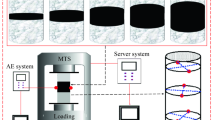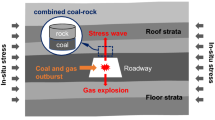Abstract
In order to further study the mechanical properties of coal–rock combined body, the conventional uniaxial compression and cyclic disturbing loading tests were carried on it by numerical simulation method. The main conclusions are as follows: Under the same rock proportion, the strength and elastic modulus of sandstone–coal–sandstone (SCS) combined body in conventional uniaxial compression test are greater than that of mudstone–coal–mudstone (MCM) combined body; and their strength and elastic modulus increase exponentially with the increase of rock proportion. In the conventional uniaxial compression and cyclic disturbing loading tests, with the increase of rock proportion, the difference of stress–strain curve shape of SCS and MCM combined bodies increases, and the peak axial strain of SCS and MCM combined bodies shows the evolution characteristics of "first decreasing and then increasing". Under the same rock proportion, the strength of SCS combined body in cyclic disturbing loading test is greater than that of MCM combined body; and their strength increases exponentially with the increase of rock proportion. The cyclic disturbing loading has two effects on the combined bodies, namely: plastic softening and plastic strengthening effects. The mutual restriction and competition of these two effects will determine the strength of combined body. Under the same rock proportion, the maximum AE hit count of MCM combined body is greater than that of SCS combined body, and the maximum AE hit count of SCS and MCM combined bodies presents the characteristics of "big at both ends and small in the middle" with the increase of rock proportion.






















Similar content being viewed by others
Availability of Data and Materials
All relevant data used to support the findings of this study are included within the article, and also available from the corresponding author upon request.
Code Availability
Data that support the findings of this study can be gained from the corresponding author upon request.
References
Chen M, Yang SQ, Zhang YC, Zang CW (2016) Analysis of the failure mechanism and support technology for the dongtan deep coal roadway. Geomech Eng 11(3):401–420
Chen SJ, Ge Y, Yin DW, Yang HS (2019) An experimental study of the uniaxial failure behaviour of rock-coal composite samples with pre-existing cracks in the coal. Adv Civ Eng, Article ID 8397598, 12 pp
Chen ZB, Li LH, Zhang YN (2020) Laboratory investigation of the mechanical properties of coal–rock combined body. Bull Eng Geol Environ 79(4):1947–1958
Chen YL, Zuo JP, Liu DJ, Li YJ, Wang ZB (2021) Experimental and numerical study of coal–rock bimaterial composite bodies under triaxial compression. Int J Coal Sci Technol 8(5):908–924
Gao FQ, Kang HP, Yang L (2020) Experimental and numerical investigations on the failure processes and mechanisms of composite coal–rock specimens. Sci Rep 10(1):13422
Gao BB, Ren CN, Dong Q, Chen LW (2021) Study on dynamic behavior law and microseismic monitoring in stoping process of roadway with high gas and wide coal pillar. Shock Vib, Article ID 5135964, 14 pp
He YC, Zhao PX, Li SG, Ho CH, Zhu ST, Kong XG, Barbieri DM (2021a) Mechanical properties and energy dissipation characteristics of coal–rock-like composite materials subjected to different rock-coal strength ratios. Nat Resour Res 30(3):2179–2193
He ZL, Lu CP, Zhang XF, Wang C, Wang BQ, Zhou T (2021b) Numerical and field investigations on rockburst risk adjacent to irregular coal pillars and fault. Shock Vib, Article ID 8830899, 17 pp
Li XL, Cao ZY, Xu YL (2020) Characteristics and trends of coal mine safety development. Energy Sources Part A Recov Util Environ Eff. https://doi.org/10.1080/15567036.2020.1852339
Li A, Ji BN, Ma Q, Liu CY, Wang F, Ma L, Mu PF, Mou L, Yang YX, Ding XS (2021) Design of longwall coal pillar for the prevention of water inrush from the seam floor with through fault. Geofluids, Article ID 5536235, 14 pp
Liu HL, Wang PT, Yang TH, Xu T, Yu QL, Xia D (2015) Mechanical characteristics of granite under uniaxial compressive and ae monitoring test using particle flow code. J China Coal Soc 40(8):1790–1795
Liu JW, Wu N, Si GY, Zhao MX (2021) Experimental study on mechanical properties and failure behaviour of the pre-cracked coal–rock combination. Bull Eng Geol Environ 80(3):2307–2321
Lu ZG, Ju WJ, Gao FQ, Yi K (2021) Influence of loading rate on the failure characteristics of composite coal–rock specimens under quasi-static loading conditions. Rock Mech Rock Eng. https://doi.org/10.1007/s00603-021-02699-2
Luo B, Sun YJ, Xu ZM, Chen G, Zhang L, Lu WN, Zhao XM, Yuan HQ (2021) Damage characteristics and mechanism of the 2017 groundwater inrush accident that occurred at Dongyu Coalmine in Taiyuan, Shanxi, China. Water, Article ID 368, 12 pp
Mu K, Li TB, Yu J, Cai YY, Liu SY, Tu BX, Jiang HC (2014) Mesoscopic simulation of relationship of acoustic emission and compressive deformation behavior in sandstone under confining pressures effect. Chin J Rock Mech Eng 33(S1):2786–2793
Pan B, Yu WJ, Shen WB (2021) Experimental study on energy evolution and failure characteristics of rock–coal–rock combination with different height ratios. Geotech Geol Eng 39(1):425–435
Van der Merwe JN (2006) South African coal pillar database. J S Afr Inst Min Metall 106(2):115–128
Xin HQ, Li QH, Liu L, Liu ZJ, Hou JM (2021) Analysis on the influence of fault protection coal pillar size on rockburst. Geofluids, Article ID 5563347, 11 pp
Xue JH, Chen ZH, Li YH, Wang JY, Li X (2022) Failure characteristics of coal–rock combined bodies based on acoustic emission signals. Arab J Geosci 15(2), Article ID 135
Yang YJ, Zhao NN, Ma DP, Zhang FJ (2016) Study on stability of strip coal pillar with different moisture content. J Min Saf Eng 33(1):42–48
Yang L, Gao FQ, Wang XQ, Li JZ (2019) Energy evolution law and failure mechanism of coal–rock combined specimen. J China Coal Soc 44(12):3894–3902
Yang L, Gao FQ, Wang XQ (2020) Mechanical response and energy partition evolution of coal–rock combinations with different strength ratios. Chin J Rock Mech Eng 39(S2):3297–3305
Zhang YL (2014) Numerical simulation study on the landslide process and impact disaster. M.S. Thesis. Hohai University, Nanjing, China
Zhang HW, Elsworth D, Wang ZJ (2018) Failure response of composite rock-coal samples. Geomech Geophys Geo-Energy Geo-Resour 4(2):175–192
Funding
This research was supported by the Natural Science Foundation of Inner Mongolia Autonomous Region (Grant No. 2021BS05002) and the Natural Science Innovation Foundation of Inner Mongolia University of Science and Technology (Grant No. 2019QDL-B25).
Author information
Authors and Affiliations
Corresponding author
Ethics declarations
Conflict of interest
The authors declare that they have no conflict of interest.
Additional information
Publisher's Note
Springer Nature remains neutral with regard to jurisdictional claims in published maps and institutional affiliations.
Rights and permissions
Springer Nature or its licensor holds exclusive rights to this article under a publishing agreement with the author(s) or other rightsholder(s); author self-archiving of the accepted manuscript version of this article is solely governed by the terms of such publishing agreement and applicable law.
About this article
Cite this article
Duan, H., Xiong, S. & Yu, W. Numerical Simulation Study on Mechanical and Acoustic Emission Characteristics of Coal–Rock Combined Body Subjected to Cyclic Disturbing Loading. Geotech Geol Eng 41, 783–802 (2023). https://doi.org/10.1007/s10706-022-02304-5
Received:
Accepted:
Published:
Issue Date:
DOI: https://doi.org/10.1007/s10706-022-02304-5




